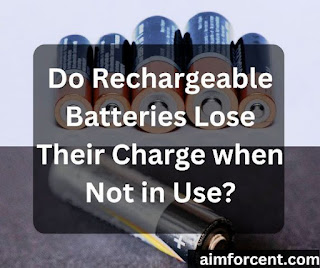Do Rechargeable Batteries Lose Charge If Not Used?
Rechargeable batteries are a convenient and cost-effective source of power, so many customers prefer such batteries instead of using regular batteries. Do you know the drawback of rechargeable batteries? They lose charge even when not in use. How can you resolve such issues by maximizing the battery lifespan? In this blog, I am going to cover it. If you have questions, do not hesitate to ask in the comment below.
First, let me explain:
How Do Rechargeable Batteries Work?
- Rechargeable batteries convert electrical energy into chemical energy by storing it in the battery’s electrodes.
- When the battery is discharged, the chemical energy is converted back into electrical energy.
- This electricity powers your device.
Different types of rechargeable batteries, such as nickel-cadmium (NiCd), nickel-metal hydride (NiMH), and lithium-ion (Li-ion), have different chemistries and operating characteristics. However, they all work on the same principle of converting electrical energy into chemical energy and back again. I have covered the process in many of my posts.
Do Rechargeable Batteries Lose Charge If Not Used?
Yes, rechargeable batteries do lose charge if not used. When a rechargeable battery is not used, it gradually loses some of its charges due to self-discharge.
Self-discharge occurs when the battery’s chemical reactions continue to occur even when the battery is not being used. It leads to a gradual loss of the battery’s charge over time. The rate of self-discharge varies depending on the type of battery, its chemistry, and its age.
For instance, NiCd batteries have a higher self-discharge rate than Li-ion batteries, which means they lose their charge more quickly when not in use.
On the other hand, Li-ion batteries have a longer overall lifespan and are less prone to the memory effect, a phenomenon in which the battery loses capacity if not discharged fully before recharging.
How to Maintain the Charge of Your Rechargeable Batteries?
To maintain the charge of rechargeable batteries, there are several things you can do. Here are some tips to help you keep your rechargeable batteries charged and ready for use:
Use the Right Charger
Using the right charger is essential for maintaining the charge of your batteries. Each type of rechargeable battery has its own charging requirements, so it is important to use a charger that is specifically designed for your battery type. Using the wrong charger or third-party charger may damage your battery, reducing its lifespan.
Charge Batteries Regularly
To prevent self-discharge, you should charge your rechargeable batteries regularly. The frequency of charging depends on the type of battery and how often it is used. For instance, a smartphone battery may need to be charged twice a week, while a camera battery may only need to be charged once every few weeks.
Store Batteries Properly
When storing rechargeable batteries, always keep them in a cool and dry place. Always keep them away from direct sunlight and heat sources. Avoid storing batteries in extreme temperatures, as this can damage the battery and reduce its lifespan.
Avoid Overcharging
Do not overcharge rechargeable batteries. The truth is, if you want, you cannot do this in most of the recent batteries because the devices come with auto-cut technologies. However, such habits degrade the battery life. I also suggest using the specific battery charger for your device designed by the manufacturers.
Use the Battery Regularly
Using the battery regularly helps to maintain its charge. When a battery is not used for an extended period, it is more likely to lose its charge due to self-discharge. By using the battery regularly, you can prevent this from happening and ensure that it remains charged and ready for use.
Consider Battery Conditioning
Battery conditioning is a process in which the battery is fully discharged and then recharged to improve its overall performance. Do you know it helps to reduce the self-discharge rate and increase the battery’s overall lifespan? However, not all rechargeable batteries can be conditioned, so it is important to check the manufacturer’s instructions before attempting this process.
Replace Old Batteries
Finally, replace old rechargeable batteries when they reach the end of their lifespan. Over time, rechargeable batteries lose their capacity and ability to hold a charge, even if they are not used. If you notice that your battery is not holding a charge as well as it used to, it may be time to replace it.
Do you want to learn more about the appropriate use of rechargeable batteries, please read my other posts too:
How Many Hours Do Rechargeable Batteries Last Per Charge?
How Long Does It Take to Charge a 1500 mAh Battery?
Meet Rohan, a writer who loves to inspire and motivate others. He’s all about those feel-good quotes that can light up your day! When he’s not crafting words of encouragement, Rohan dives into the world of the latest technologies, exploring what’s new and exciting. But that’s not all—his heart beats for solar products, the kind that harness the power of the sun for a greener future. And guess what? He’s a total pet lover too! When he’s not busy writing, you’ll find Rohan surrounded by his furry friends, spreading joy and cuddles all around. Follow Rohan on Twitter and Facebook







